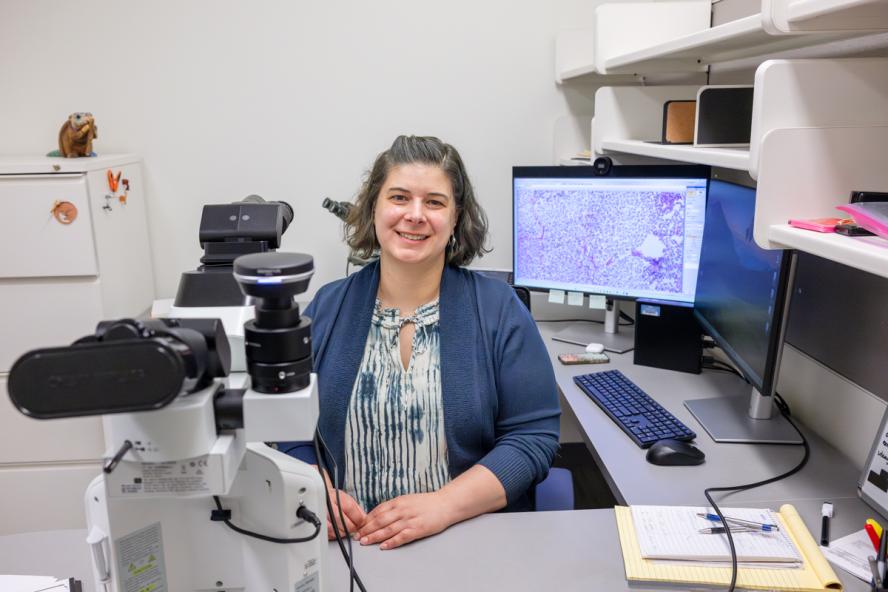Dr. Laura White (she/her) is the new associate director of Cummings School Veterinary Diagnostic Lab (CVDL) and associate clinical professor in the Department of Comparative Pathobiology at Cummings School of Veterinary Medicine at Tufts University. Her career path has crisscrossed the country—from the University of Tennessee to North Carolina State University to Washington State University—as she developed her expertise in laboratories, classrooms, and clinics to take on this new role leading the CVDL.
“Here at Cummings Diagnostic Lab, there are some great opportunities; it’s poised for growth. I’ve accumulated experience that I can apply to support all the great work that the lab is already doing,” says White, who started in mid-April.
Though she has practiced all over the United States, her story begins nearby. Originally from New Hampshire, White knew where her career was headed early on. “I was one of those kids from when I was little that said I wanted to be a veterinarian. I always liked animals.”
White earned her bachelor’s degree in neuroscience and behavior at Vassar College. She volunteered at a local veterinary clinic to help socialize stray cats. After graduating, she was awarded a post-baccalaureate research fellowship at the National Institutes of Health (NIH), studying brain lipid metabolism. Throughout her career, she has collaborated on a number of research projects, though her main focus would be on a different avenue of veterinary medicine.
At the University of Tennessee College of Veterinary Medicine, White considered small animal clinical practice and specialties like cardiology and neurology while pursuing her D.V.M., but in the end, anatomic pathology landed on top. Before becoming a pathologist, she decided to first gain experience in clinical practice.
White moved west to for a rotating internship at VCA Alameda East Veterinary Hospital in Denver, and stayed in Colorado another two years as an overnight emergency clinician at VCA Douglas County Animal Hospital.
“I really liked emergency medicine. I’m good at staying calm in busy situations, and I like a bit of chaos. You get to get to see a little of everything in emergency medicine. That’s part of why I like pathology too,” she says.
When White started up her residency in anatomic pathology at North Carolina State University College of Veterinary Medicine, she immediately recognized the value of having that clinical practice background.
“Having done clinical service really helps as a pathologist,” she says. “I need to know my esoteric pathology world, and I also need to convey this information to doctors. It helped in that aspect of how I communicate with doctors.”
The how and why of diagnostic pathology and necropsy intrigued her from the start.
“Death is a part of life, and one of the things I didn’t expect going into pathology is that I get to potentially provide closure to the owner,” says White. “I also get to provide information to help treat the next animal that comes in with that diagnosis.”
After residency, White spent eight years on the West Coast at Washington State University (WSU) in the Washington Animal Disease Diagnostic Laboratory (WADDL). She performed clinical diagnostic work for the veterinary school and the state diagnostic lab, including necropsies and biopsies, often for large animals in herds.
“At WSU, I gained an appreciation of how different medicine is when dealing with herd versus individual animals,” White says. “When a dog comes into a clinic, you’re concerned with how to treat that animal specifically. When it’s an animal coming from a herd with something infectious, one animal can have an impact on hundreds of animals.”
White’s professional scope broadened into teaching at WSU. As an assistant clinical professor, she trained residents (eventually becoming the residency program director) and veterinary students on rotation in WADDL.
“It’s fun to have that one-on-one interaction with students and see that lightbulb in their eyes when they connect what they’ve learned in the classroom,” she says.
White added didactic teaching to the mix at WSU, delivering lectures to second- and third-year veterinary students and teaching a course on Systemic Pathology.
“I enjoy learning about learning—learning best teaching habits and what prevents students from learning,” says White. “I focus on making learning as practical as possible, with real-world examples, and showing students how pathology can teach you to be a better clinician in the future.”
On the research side, White supported WSU researchers with diagnostic pathology services, running histopathology on lymphoma samples and soft tissue sarcomas, providing diagnoses, and grading tumors.
“It’s a different way to use my expertise, looking at histopathology and pathology samples as a piece of the puzzle for clinicians,” says White.
